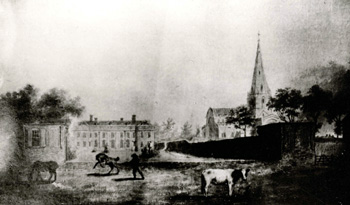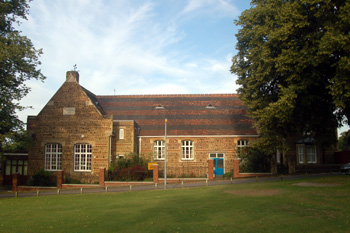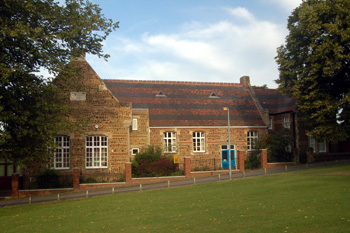Pulfords School Leighton Buzzard

All Saints church and Prebendal House 1797 [P91/28/40]
Before 1853
Joshua Pulford wrote his will on 10th May 1710 in which he left property and land, the income from which was designed to support the Vicar of Leighton Buzzard, so that his stipend reached £100 a year. Any surplus income was to be used to educate poor children. As the value of the land fell so the surplus fell and to make up the difference the Vicar took to donating two guineas per annum to a school in the town. Pulford's Charity, in combination with that of Charles Leigh (in whose will of 5th June 1704 £10 per annum was given to support a schoolmaster in Leighton Buzzard who was expected to teach ten poor boys, chosen by the Vicar and Churchwardens of All Saints) provided an early education in the town.
The history of the school in the late 18th and early 19th century is somewhat unclear. In 1818 a return was made by Leighton Buzzard to a national questionnaire on education. This return is somewhat puzzling as it declares there to be no educational endowments in the town, despite Leigh's and Pulford's charities. The return notes the Lancasterian School established in 1812 and describes it thus: "supported by subscription, in which about 60 children are instructed; and about the same number attend the day schools, all of which are at Leighton Buzzard". The return opined: "The poor are desirous of the means of education". Thus there this no specific mention of a school maintained by Pulford's and/or Leigh's Charities, unless it is one of the other day schools noted in passing.
Another return to a national questionnaire, in 1833, notes "One Day and Sunday School of the Established Church, attended by 30 males daily, and 51 on Sundays. The master is allowed £10 per annum by the Lord of the Manor for instructing 10 gratuitously, and £10 for conducting the Sunday School".

Pulford's School in 1901 buildings in red
1853 to 1903
Bedfordshire & Luton Archives & Records Service has, in the Leighton Buzzard parish deposit, two minute books for the management of Pulford's Schools [P91/25/1-2]. The first meeting is dated 6th July 1853: "At a meeting of the Board of Management of Pulford's Leighton Buzzard Schools held this day in the School Room on Church Square, Leighton Buzzard, being the first meeting of the said Board held pursuant to the directions contained in the Scheme for the management of the said Schools…" The premises were on the east side of Church Square as an from the late 19th century notes written on blank pages in the Parish Register for 1732 to 1774 reveals: "September 1st 1887 Post Office opened on Pulford's old site". Clearly, however, a day school had been in existence prior to 1853 as some of the items of business at the first meeting reveal: "A Latter from the Rev Joseph Stevenson accompanying a statement of moneys expended in the conduct and carrying on of the School having been read the said statement was taken into consideration by the Board and allowed and payment of the amount £46.4.8 directed to be paid by the Treasurer to Mr.Stevenson…It having been intimated to the Board that the present School Mistress would cease her engagement as such on the 25th instant, it was decided that the Vicar should be requested to advertise or otherwise endeavour to procure a candidate to supply her place…" Craven & Company's Commercial Directory for 1853 notes Ann Short as mistress of the school. Incidentally The Post Office Directory for 1847 notes a Free School in Church Square of which William Thomas Woodley was master. Slater's Directory of 1850 also notes a Free School in Church Square, again with Woodly as master.
A return to the Church School questionnaire of 1846/7 notes no daily church school. It seems most likely that, at this date, Pulford's School was not regarded as a church school (it is called a Free School) but clearly by 1853 it was being run by the church since the committee consisted of Edward Lawford (a great benefactor to All Saint's Church), Charles Pettit, Richard Walker, Richard Doggett, Edward Lawford junior, William Allen "Nominee of Colonel Hanmer" [the Lord of the Manor] and the two churchwardens William Green and John Ellis.
It is probably significant that the entry for the first meeting talks of managing "the Schools" whereas the expenses, put in by the Vicar for the period before 1853 are for "carrying on of the School". This might indicate that there were separate schools for boys and girls from 1853, the previous school either having been purely for boys (as per Leigh's charitable bequest) or having been a single mixed school. Certainly Ann Short's replacement, Clara Hart was "as Teacher of the Girls' School". In 1870, as part of the Education Act, a return was sent in from each parish, that from Leighton Buzzard noted Pulford's Boys School, with accommodation for 104 and stated that further accommodation for girls in the town would be less pressing "if the Pulford Church of England Girls' School is at once made efficient, by laying down a brick floor and appointing a certificated teacher".
The old Pulford's School premises were sold on 20th March 1883 for £1,000 [P91/1/2]. The new school, in Parsonage Close, was begun on 18th June 1883 and opened on 31st March 1884 [P91/1/2]. The early 1890s saw some significant changes to the school. The premises needed additional work and the school had no money, consequently it was decided to subject the schools to government control in return for a grant to improve matters. Then in April 1893 it was decided, with the managers of Saint Andrew's Schools, to convert Pulford's into a boys' school and Saint Andrew's into a girls' school, boys from Saint Andrew's moving to Pulford's and girls at Pulford's moving to Saint Andrew's on 15th May that year. At the same time both schools became free to pupils, a subscription having been paid by parents hitherto.

Pulford's Church of England VA Lower School June 2008
1903 to 1946
The Education Act of 1902 abolished School Boards, replacing them with a Local Education Authority which, for Bedfordshire, was Bedfordshire County Council. Thus board schools became known as council schools. Remaining National and British Schools as well as other free, charity and church schools became Public Elementary schools, partially controlled by the Local Education Authority. The minute in the Pulford's Management Board minutes for 13th August 1903 [P91/25/1] reads: "An order having been received from the Bedfordshire County Council to submit to the County Council the names of the foundation managers proposed to be appointed the meeting proceeded to their election. It was unanimously agreed that the Vicar of the Parish (for the time being) with Messrs F.Pledger, R.Richmond and S.Willis should be the four foundation managers for the Pulford Schools under the New Education Act of 1902. It was unanimously resolved that the name of Mr.George Payne be submitted to the County Council for appointment as manager by the County Council. It was intimated to the managers by Mr.D.T.Willis, as clerk of the School Board, that Mr.Chapman had been selected by the minor local authority [Leighton Buzzard Urban District Council] as the manager proposed to be appointed by them".
Bedfordshire & Luton Archives & Records Service has a scrapbook of cuttings of visits made to most Bedfordshire Schools by School Inspectors for a period from just before the First World War through the inter-war years [E/IN1/1]. The first inspection noted in the volume was in 1910: "The boys are in good order…It is very regrettable that arrangements cannot be made for the boys in the upper division to avail themselves of the Wood-work Centre. Many of them are intelligent lads who would probably derive considerable profit from a course of "Hand and Eye" training. Neither the heating nor ventilation of the rooms is satisfactory".
The next inspection came two years later when average attendance was 98. The inspector noted: "The order and tone of this School are praiseworthy and considerable improvement has been effected since it was last reported upon: the general level of efficiency is now quite good. It is to be regretted that the Managers have not been able to arrange for the instruction of the older boys in Woodwork".
The next inspection in the volume comes from 1921: "The present Head Master has been in charge of this School since 1st April 1921, and he has done much to raise the School to a more satisfactory condition, but much still remains to be done. The Master is aware of the weaknesses and is doing his best to improve the Arithmetic, Writing, Composition, Singing and Drawing". Soon after this an inspection was made of the premises: "Owing to the height of the windows above the floor level the main room is not well-lighted - at one end especially, and the classroom for the youngest boys is dark. Artificial lighting has to be used here much more often than need be the case were the windows enlarged. The cloakrooms are rather small. The urinal is too small for the numbers in average attendance; although there is a perpetual flushing the smell is offensive. The walls of the urinal, coal shed, closets and lavatory, are all damp. The force of water for the lavatory is weak, so there may be a leak. At any rate this needs investigation and improvement. There is no playground here".
In 1924 the inspector noted: "The Head Teacher is an energetic worker, with the interests of the boys thoroughly at heart, and the condition of the School is improving. Many of the boys come from poor homes, and a really good level of attainment is not easy to reach". Two years later the inspector concentrated on gardening: "The range of garden work is rather narrow; no fruit or flower propagation work is attempted, but a good number of vegetable crops is grown. One or two old standard fruit trees in the garden are badly infected with American Blight and should be grubbed. The plots are not in a high state of cultivation. A few suitable experiments are carried out each year. Produce goes to the school centre. Indoor work is better than that on the garden. Fair records are kept by scholars and they also make a plan of the garden and show the cropping. A good course of science related to gardening is given in the classroom and this is based manly upon experiments"
The following year the inspector returned to looking at the school as a whole; average attendance was 75: "This School is still improving: the main criticism necessary is that made in the last report - the style of writing and of figures, is careless and untidy looking" however: "the boys have done well, for so small a school, in both Cricket and Football". Two years later, with average attendance down to 67: "This School continues to do good work. the standard of neatness has improved in many cases…the School also has done well in sport, has won first prize for the Royal English Arboricultural Society's Competition open to the whole country in two successive years, and has a very successful Savings Bank. The Head Master deserves full recognition of his well considered and energetic work with these boys".
The final report in the volume dates to 1935, following conversion to a Junior Boys Council School for boys aged 7 to 11 (all infants now attended Beaudesert Council Infants' School): "This school was reorganised in April 1933. It has thus been working nearly two and a half years in its present form. There are 192 boys on the books [average attendance 187]. They are taught in four class rooms with a total recognised accommodation for 198. The teaching conditions, therefore, allow little freedom to organise some of the communal and practical indoor activities. The work of the School is marked by sound teaching and good attainments in the essential subjects…It is not an easy school to manage with its four teaching spaces into which more than four grades of intelligence have to be fitted. The Head Master may be congratulated on the work done and the good feeling in this school and the work of the staff also deserves recognition".

Pulford's VA Lower School June 2008
1946 to Date
This school continued until 1946 when the Education Act 1944 came into force. Under the act County Primary Schools took children up to eleven years of age, after which they sat an examination (the Eleven Plus as it was known), the top 25% then went to Cedars School, the remainder to Beaudesert (boys) or Mary Bassett (girls), later Brooklands (mixed) or Gilbert Inglefield County Secondary Modern Schools. The act also created two types of successor to the public elementary schools - the Voluntary Aided and Voluntary Controlled schools. Voluntary Aided schools are those in which the Local Education Authority funds the school but the governing body is independent, they are usually Anglican or Roman Catholic schools. Voluntary Controlled schools own their own buildings whilst the staff are employed directly by the governors. Pulford's became a Voluntary Aided County Primary Junior School, infants in the town going to Beaudesert County Primary Infants' School. At some point, it is unclear when, but sources suggest 1958, the school once more re-admitted girls as a County Primary Junior Mixed Voluntary Aided School.
In 1968 the Secretary of State approved a comprehensive reorganisation of schools by the Local Education Authority, Bedfordshire County Council. This did away with selection, all pupils attending similar schools, teaching the same curriculum, based solely on age. Children aged 5 to 9 attended lower schools, those aged 9 to 13 went to a middle school and those aged 13 to 19 attended an upper school. The council affirmed its support for the scheme in 1969 and again in 1970 and in 1974 the reorganisation reached the Leighton Buzzard area. Under the arrangements Pulford's taught children aged 7 to 11 until 1975, making the change to a lower school in 1976.
On 1st April 2009 Bedfordshire was abolished. The new Local Education Authority for Leighton Buzzard and area is Central Bedfordshire Council, a unitary council discharging both county and district functions.

Pulford's former Schoolhouse June 2008
Sources
Note that some sources may not be available in order to protect personal details
- P91/25/1-2: minutes of school managers: 1853-1903;
- P91/0/9 f.62: notes on premises: 1855;
- P91/0/9 f.4d-5: notes on the school and teachers: 1862-1896;
- P91/0/9 f.80-81: list of pupils and notes on school accommodation: 1862-1880;
- P91/0/9 f.137: notes on building of new school: 1881-1893;
- P91/0/9 f.159: chronological notes: 1886-1893;
- P91/1/2: notes on old and new premises: 1883-1884;
- Pulford's School 1892-1902;
- E/SA1/1/1: correspondence on endowment of school: 1899-1904;
- Z55/1/91/22: photograph of school: c.1900;
- E/SA3/1/2: managers' and inspector's reports: 1903;
- E/TE5/3: details of teachers: 1904-1908;
- E/TE5/4: details of teachers: 1908-1912;
- E/IN1/1: inspector's reports: 1910-1938;
- Z889/2/53: proposed alterations and addition of new buildings: 1956-1974;
- CA2/565: acquisition of additional land: 1958-1967;
- PY/PH152/1: exterior photograph of school: 1962
- CA8/389: building maintenance file: 1966-1977;
- E/TE2/2/L53: details of school: 1978;
- E/TE3/3: return of teaching staff: 1981;
- E/SA4/1/1: admissions procedure: 1982;
- E/TE3/6: return of teaching staff: 1986;
- E/MS3/2/6: kitchen and other details: c.1987